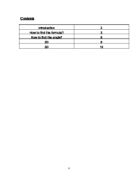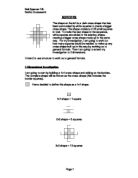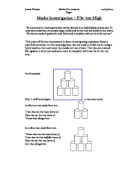- Φ(3)=1, 2. Two of the numbers are not the factors of 3.
So Φ(3)=2
- Φ(8)=1, 2, 3, 4, 5, 6, 7. Four of the numbers are not factors of 8.
So Φ(8)=4
- Φ(11)=1, 2, 3, 4, 5, 6, 7, 8, 9, 10. Ten of the numbers are not factors of 11.
So Φ(11)=10
- Φ(24)=1, 2, 3, 4, 5, 6, 7, 8, 9, 10, 11, 12, 13, 14, 15, 16, 17, 18, 19, 20, 21, 22, 23.
I will now obtain the Phi Functions from numbers of my own choice and I will try to find patterns, if any. I will try to find patterns from even numbers, odd numbers, prime numbers, squared numbers, and triangular numbers.
EVEN NUMBERS:
Φ(2)=1
Φ(4)=2
Φ(6)=2
Φ(8)=4
Φ(10)=4
Φ(12)=4
Φ(14)=6
Φ(16)=8
Φ(18)=6
Φ(20)=8
ODD NUMBERS:
Φ(3)=2
Φ(5)=4
Φ(7)=6
Φ(9)=6
Φ(11)=10
Φ(13)=12
Φ(15)=8
Φ(17)=16
Φ(19)=18
Φ(21)=12
PRIME NUMBERS:
Φ(2)=1
Φ(3)=2
Φ(5)=4
Φ(7)=6
Φ(11)=10
Φ(13)=12
Φ(17)=16
Φ(19)=18
Φ(23)=22
Φ(29)=28
SQUARED NUMBERS:
Φ(4)=2
Φ(9)=6
Φ(16)=8
Φ(25)=20
Φ(36)=12
Φ(49)=42
Φ(64)=32
Φ(81)=54
Φ(100)=20
TRIANGULAR NUMBERS:
Φ(3)=2
Φ(6)=2
Φ(10)=4
Φ(15)=8
TRIANGULAR NUMBERS CONT’D:
Φ(21)=12
Φ(28)=12
Φ(36)=14
Φ(45)=24
Φ(55)=40
Φ(66)=20
I couldn’t find any patterns from any of the types of the numbers. But I have found out that there is an easier way of finding the Phi Functions of prime numbers. I have found a formula for finding the Phi Function for prime numbers, which is “P-1”. “P” stands for Prime number.
I the second part I am going to check whether Φ(n×m)=Φ(n)×Φ(m) or Φ(n×m)≠Φ(n)×Φ(m). I am going to check the first two from the sheet.
- Φ(7×4)=Φ(7)×Φ(4)
Φ(28)=12. There are 12 numbers which are not factors of 28.
Φ(7)=6. There are 6 numbers which are not factors of 7.
Φ(4)=2. There are 2 numbers which are not factors of
4.
So Φ(7×4)=Φ(7)×Φ(4)
- Φ(6×4)≠Φ(6)×(4)
Φ(24)=8
Φ(6)=2
Φ(4)=2
So Φ(6×4)≠Φ(6)×Φ(4)
I am now going to check whether or not Φ(nxm)=Φ(n)xΦ(m) for at least two separate choices of my own of n and m.
- Φ(2×8)=Φ(2)×Φ(8)
Φ(16)=8. There are 8 positive numbers less than 16 which are not factors of 16.
Φ(2)=1. There is 1 positive number less than 2 which is not a factor of 2.
Φ(8)=4. There are 4 positive numbers less than 8 which are not factors of 8.
So Φ(2×8)≠Φ(2)×Φ(8)
- Φ(7×3)=Φ(7)×Φ(3)
Φ(21)=12
Φ(7)=6
Φ(3)=2
So Φ(7×3)=Φ(7)×Φ(3)
For the third part I am investigating why Φ(n×m)=Φ(n)×Φ(m) whilst in other cases this is not so. I have found out that it depends on the types of numbers used as n and m. Now I will check whether or not Φ(n×m)=Φ(n)×Φ(m) for different types of choices of n and m.
-
Even numbers of n and m.
Φ(6×4)=Φ(6)×Φ(4)
Φ(24)=8. There are 8 positive numbers less than 24 which are not factors of 24.
Φ(6)=2. There are 2 positive numbers less than 6 which are not factors of 6.
Φ(4)=2. There are 2 positive numbers less than 4 which are not factors of 4.
So Φ(6×4)≠Φ(6)×Φ(4)
- Odd numbers of n and m.
Φ(9×9)=Φ(9)×Φ(9)
Φ(81)=54
Φ(9)=6
Φ(9)=6
So Φ(9×9)≠Φ(9)×Φ(9)
- Co-prime numbers of n and m.
Φ(5x3)=Φ(5)xΦ(3)
Φ(15)=9. There are 9 positive numbers less than 15 which are not factors of 15.
Φ(5)=4. There are 4 positive numbers less than 5 which are not factors of 5.
Φ(3)=2. There are 2 positive numbers less than 2 which are not factors of 3.
So Φ(5×3)=Φ(5)×Φ(3)
- n(odd) and m(even).
Φ(9x4)=Φ(9)xΦ(4)
Φ(36)=14
Φ(9)=6
Φ(4)=2
So Φ(9×4)≠Φ(9)×Φ(4)
- n(prime) and m(even).
Φ(7x4)=Φ(7)xΦ(4)
Φ(28)=12. There are 12 positive numbers which are not factors of 28.
Φ(7)=6. There are 6 positive integers which are not factors of 7.
Φ(4)=2. There are 2 positive integers which are not factors of 4.
So Φ(7×4)=Φ(7)×Φ(4)
I have found out that there are two ways of having Φ(nxm)=Φ(n)xΦ(m). The first way is that n and m should be co-prime. The other way is that either n or m should be prime and even. The rest of the number types result Φ(n×m)≠Φ(n)×Φ(m).
I have to investigate “Φ(Pⁿ Q )” if P and Q are prime in the fourth part. I have found two formulas for finding the Phi Functions of large numbers. One of the formulas is “(Pⁿˉ¹)(P-1)”. The other formula is “Pⁿ(1-1/P)”.
FIRST FORMULA:(Pⁿˉ¹)(P-1)
To find Φ(81):
1. Firstly the 81 has to be split up into prime numbers.
81 converted into prime numbers=3
So the formula can now be used to find Φ(81):
2. (3 ˉ¹)(3-1)=
3. 3³×2
4. 54
So Φ(81)=54
SECOND FORMULA: Pⁿ(1-1/P)
To find Φ(81):
- Firstly 81 has to be split into prime numbers.
81 converted into prime numbers=3
So the formula can now be used to find Φ(81):
- 3 (1-1/3)=
- 81×2/3=
- 54
So Φ(81)=54
The two formulas give out the same results for the Φ(81). The “P” on the formulas stands for prime number. The formulas are faster at finding the Phi rather than writing all the numbers out and cancelling or circling them. There are four steps to work out the Phi’s from the formulas and that is why I have numbered my working out.







